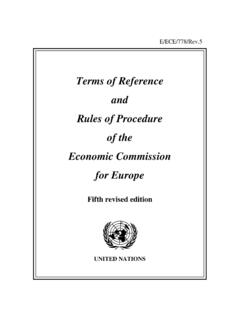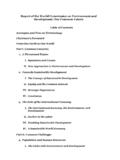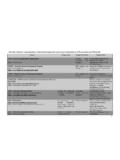Transcription of SOCIAL AND ECONOMIC CONSEQUENCES OF ROAD …
1 ETSC couverture (AvL).indd 118/04/07 10:51:12 SOCIAL AND ECONOMIC CONSEQUENCES OF ROAD TRAFFIC INJURY IN EUROPEB russels 2007 European Transport Safety CouncilRue du Cornet 22B 1040 BrusselsTel: 0032 2 230 4106 Fax: 0032 2 230 4215email: AND ECONOMIC CONSEQUENCES OF ROAD TRAFFIC INJURY IN EUROPEB russels 2007 European Transport Safety CouncilRue du Cornet 22B 1040 BrusselsTel: 0032 2 230 4106 Fax: 0032 2 230 4215email: 2007 European Transport Safety CouncilExtracts from this publication may be reproduced with the permission of ETSCISBN: 97890760242713 AcknowledgementsETSC gratefully acknowledges the contributions of members of ETSC s Injury Working Party to this Review:Mr. Rune Elvik (Chairman) Mr. Per OrtenwallMr. Murray Mackay (Deputy Chairman) Mr. Jan PelckmansMr. Jes s Monclus (Deputy Chairman) Mr.
2 Jan TeclMr. Walter Buylaert Mr. Jesper S lundMr. P ter Holl Ms. Elaine WodzinMr. Finn Kronborg Mazanti Mr. Antonio Avenoso (ETSC)ETSC is grateful for the financial support provided by 3M, BP, Diageo, KeyMed, Shell International, Toyota and the Volvo Group. The contents of this publication are the sole responsibility of ETSC and do not necessarily reflect the view of sponsors or organisations to which research staff participating in the Working Party belong. The European Transport Safety CouncilThe European Transport Safety Council (ETSC) is an international non-governmental organisation which was formed in 1993 in response to the persistent and unacceptably high European road casualty toll and public concern about individual transport tragedies. Cutting across national and sectoral interests, ETSC provides an impartial source of advice on transport safety matters to the European Commission, the European Parliament and, where appropriate, to national governments and organisations concerned with safety throughout europe .
3 The Council brings together experts of international reputation and representatives of a wide range of national and international organisations with transport safety interests to exchange experience and knowledge and to identify and promote research-based contributions to transport safety. Executive Director:Dr. J rg BeckmannBoard of Directors:Professor Herman De Croo Professor Manfred BandmannProfessor G. Murray MackayProfessor Pieter van VollenhovenProfessor Richard AllsopMr. Paolo Costa, MEPDr. Dieter Koch, MEP45 CONTENTSE xecutive summary 61 Background and introduction 82 The true scope and impacts of traffic injury Official (police-reported) road accident statistics are incomplete, inaccurate and biased Problems in defining and comparing levels of injury severity Results of the ETSC Review on Accident Data in the enlarged EU Costs to society of traffic injury 163 Long-term impacts of traffic injury The long-term impacts of traffic injury.
4 A white spot on the map Universal outcome scales Organ-related outcome scores Problems and pitfalls Burden of injury Psychological CONSEQUENCES of traffic accidents and ECONOMIC impact on society Injuries to specific organs Job loss associated with long leaves Impact on families Impacts of being prosecuted for manslaughter as a result of an accident Summary and conclusions 264 Socio- ECONOMIC dimensions of traffic injury France Great Britain Norway Sweden Canada The United States of America Can anything be done to reduce the effect of SOCIAL status on accident risk? Summary of knowledge regarding SOCIAL disparities in risk Other issues related to socio- ECONOMIC factors and road accidents 345 Conclusions and recommendations Incomplete and inaccurate accident reporting Long-term impacts of traffic injury Socio- ECONOMIC dimensions of traffic injury 38 References 416 Executive summaryThis report summarises current knowledge regarding the following socio- ECONOMIC aspects of traffic injury in europe :1.
5 The completeness and accuracy of official road accident statistics2. Long-term impacts of traffic injury3. SOCIAL disparities in road accident risk1. The completeness and accuracy of official road accident statisticsOfficial road accident statistics are incomplete and inaccurate in all countries. The level of reporting for injuries treated in hospitals is, on the average, less than 50%. Injuries are not always correctly classified by severity in police accident reports. The report makes the following recommendations for research and policy making to improve the quality of official road accident for researchThe following recommendations are made for research designed to estimate the true incidence and societal cost of traffic injury:1. Studies designed to assess the level of reporting in official road accident statistics should be performed Studies should address factors that influence the likelihood that an injury will be reported in official accident statistics and try to assess the amenability of these factors to interventions designed to improve the actual level of Studies should be made to determine the extent to which injuries recorded by medical institutions can be geographically located Studies should be made to determine the possibility of electronically merging police records and hospital records of traffic injury in ways that will not violate protection of privacy and personal Guidelines based on research should be developed regarding the essential elements of a common approach to the estimation of
6 The costs to society of traffic for policy makingThe following recommendations are made regarding policy making and the administration of injury recording systems:1. A simple injury scale should be developed for use by the police and other emergency services. Final classification of injuries according to severity should be performed by medical Countries should provide training in the use of the AIS in order to make the use of this scale more common and thus make injury data more comparable between Countries should encourage electronic linkages between sources of injury data, like STRADA in Sweden or the CODES system of the United Countries should regularly monitor the level and accuracy of reporting in official road accident statistics and make the results of studies available to other Countries should regularly provide a set of ECONOMIC valuations of the benefits to society of preventing road accident deaths and injuries for use in cost-benefit analyses of road safety Long-term impacts of traffic injuryLong-term impacts of traffic injury are poorly documented in all countries.
7 Little is known about these impacts. There are, however, reasons to believe that an increasing number of people live with lasting impairments as a result of traffic injury. The following recommendations are made for research and policy for researchThe following recommendations are proposed for research:1. Studies should be made to assess the applicability of various quality-of-life scales for the purpose of describing systematically the long-term impacts of traffic Surveys of the general population should be made at regular intervals to determine the incidence and prevalence of lasting impairments as a result of traffic Studies should be made to assess the incidence of mild traumatic brain injury as well as its long-term socio- ECONOMIC for policy makingThe following recommendations are made for policy making:1.
8 Countries are recommended to adopt a consensus-based prospective injury impairment scale based on the Abbreviated Injury Scale (AIS).2. The number of people living with lasting impairments as a result of traffic injury is likely to be increasing. The EU and member states should therefore consider adopting targets for reducing not just deaths, but also serious The EU should encourage member states to adopt a common definition of slight and serious injuries and of lasting impairments. Implementing common definitions of these concepts would make road accident statistics more comparable across countries than they are Programmes designed to treat accident victims who suffer long-term impacts of injury, like post traumatic stress disorder, should be further developed and their effects SOCIAL disparities in road accident riskSocial disparities in road accident risk are also not very well known.
9 However, most studies show that individuals who have a low SOCIAL status are more frequently involved in road accidents than individuals who have a high SOCIAL status. This tendency applies to all groups of road users. The following recommendations are put forward with respect to SOCIAL disparities in road accident for researchThe following recommendations are made for research:1. Countries that have not studied the association between SOCIAL status and road accident risk are encouraged to do Studies should be made to determine which variables are the strongest predictors of SOCIAL disparities in road accident risk: education, income, quality and characteristics of residential area, or any combination of these Studies should be made to identify factors that may explain why road accident risk is associated with SOCIAL status, in particular if differences in road user behaviour mediate this Studies should be made to determine if SOCIAL disparities in road accident risk vary according to injury severity or group of road for policy makingThe following recommendations are made for policy making:1.
10 Countries are encouraged to develop policies designed to reduce SOCIAL disparities in road accident risk, to the extent that these are regarded as A systematic use of traffic calming in residential areas for the purpose of reducing SOCIAL disparities in road accident risk is Policies aimed at modifying unsafe road user behaviour associated with low SOCIAL status should be Background and introductionAccording to the World Health Organisation (WHO, 2004), approximately 16,000 people die everyday worldwide from all types of injuries. Injuries represent about 12% of the global burden of disease, making injuries the third most important cause of overall mortality. Deaths from traffic injury are a very significant part of the problem accounting for 25% of all deaths from 2004, the estimated annual costs, both direct and indirect, of traffic injury in the EU-15 countries exceeded 180 billion euros.










